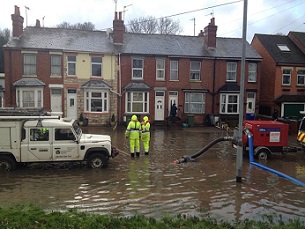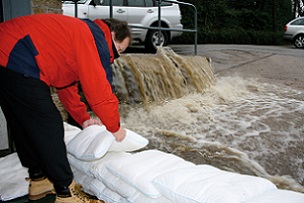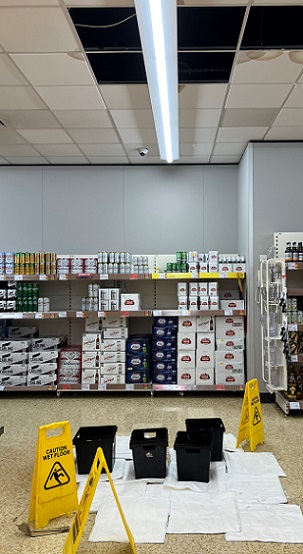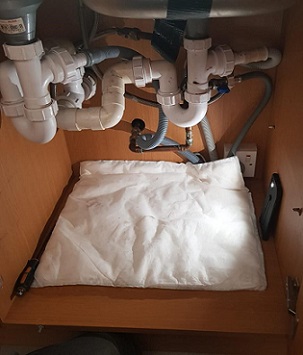 Summer flooding is even more destructive than winter flooding according to Aviva insurance
Summer flooding is even more destructive than winter flooding according to Aviva insurance
 A wall of FloodSax alternative sandbags holding back a torrent of summer floodwater
A wall of FloodSax alternative sandbags holding back a torrent of summer floodwater
 All these 20 FloodSax sandless sandbags came from this one easy-to-carry box
All these 20 FloodSax sandless sandbags came from this one easy-to-carry box
 Supermarkets and other big businesses now rely on FloodSax to soak up drips, leaks and spills for maximum customer safety
Supermarkets and other big businesses now rely on FloodSax to soak up drips, leaks and spills for maximum customer safety
 FloodSax can be used to prevent damage from leaks in some of the most inaccessible places in your home
FloodSax can be used to prevent damage from leaks in some of the most inaccessible places in your home
UK’s biggest insurance company hit with more flooding claims in summer than winter ... and here's why
The UK’s biggest insurance company says it’s now getting more flooding claims in summer than winter and stresses that people must be constantly prepared for flooding.
Aviva, which has 18 million customers, has revealed that more than a third of its home insurance flood claims happen between June and August … and the areas in the UK where the flooding is happening and the reasons for it differ from winter to summer too.
It means people must always be prepared for flooding and one quick and easy way is to always have a stock of FloodSax alternative sandbags as they come vacuum-packed in bags of five for space-saving storage in homes and businesses.
In winter, floods can often happen after rivers burst their banks and the ground is too sodden it can’t cope with any more water with winter floods more common in the north west, south west and northern England.
However, the summer months see a peak in flash flood claims in Greater London, the south east and the east of England, often made worse by people paving over their gardens or laying down artificial grass. This means that a massive deluge of water from a cloudburst has nowhere to go except into people’s homes and businesses.
Jason Storah, Chief Executive of UK & Ireland General Insurance at Aviva, said: “Traditionally, we think of floods happening in the autumn and winter when rainfall occurs over a period of time and rivers reach capacity. However, this analysis shows that floods can and do occur at any time and summer flash floods are becoming more commonplace.
“This pattern of flood claims suggests that residents and businesses should be prepared for floods at any point during the year and put in place a flood action plan.
“While residents and business owners may be more aware of the risks to their properties if they are close to water, one in five properties is at risk from surface water or flash floods which can be unexpected, particularly when we’ve experienced hot, dry days.
“Flash floods can catch us off guard as they are sudden and harder to predict so we’d urge people to get ready and take action to protect their homes or businesses.”
According to Aviva, the worst month for flooding claims for both homes and businesses is traditionally December which accounts for 17% with July and August next on 12% and January fourth on 10%. The months with the least claims are April with 2.1% (despite the thought that it’s a month of showers), May on 3.5% and March on 3.6%. The other months are October (9.3%), February (8.9%), June (8.7%), November (6.7%) and September (6.5%).
In five out of the last 10 years, (2016, 2018, 2020, 2021 and 2022), Aviva received the most flood claims during the summer, with significant spikes in August 2020 and July 2021 when London was badly flooded twice in a couple of weeks.
One of the ways people can be prepared for flooding 24 hours a day and 365 days a year is to have some FloodSax alternative sandbags in their homes and businesses as they take little space to store yet are quick and easy to deploy.
One major European insurance company is now providing its customers with FloodSax in a bid to keep the flooding out and their insurance payout costs down.
The typical cost of repairing the damage in a flooded home is more than £30,000 and it’s more than double that for a commercial business.
FloodSax are multi-purpose and can be used both inside and out.
They come vacuum-packed in fives but immerse them in water and the gelling polymer inside the FloodSax absorbs and retains water so the FloodSax expands into an instant alternative sandbag that can be quickly and easily built into barriers to keep floodwater out.
In their dry state the gelling polymer inside FloodSax can soak up water dripping or leaking inside buildings to stop damage from spreading and they are used extensively like this in homes, businesses and public buildings such as supermarkets and hospitals. They are very thin with a large surface area so can be slipped underneath leaking radiators, boilers, sinks and water pipes.
Lucy Bailey from Yorkshire company Environmental Defence Systems Ltd which invented the FloodSax said: “We have now sold around three million FloodSax worldwide since 2007 and they are the original and best sandless sandbag. Local authorities have no responsibility to provide sandbags or any other flood defence device so we would echo Aviva’s advice that it’s up to people to protect their own property from flooding.”
FloodSax retail for around £140 for a box of 20 yet can save tens of thousands of pounds in water damage to floors, electrics, furniture and walls.
Aviva has warned that the flood risk is worsened by the growing problem of what is known as urban creep with people paving over gardens and putting down artificial grass which is adding significantly to flooding, especially in inner city areas.
Jason added: “As urban areas can be particularly susceptible to flash floods we’d also encourage people to consider their outside spaces, ideally including permeable materials such as lawns, plants or softer landscaping materials like gravel to help water to drain.”
According to research commissioned by Aviva among more than 2,000 homeowners, over a quarter (27%) have already or plan to replace part or all of their garden with a driveway made from non-permeable material. A further 21% would consider making the change.
A fifth (21%) have already switched their natural lawn with artificial grass or plan to, with a further 19% considering the swap.
Unfortunately, impermeable surfaces and a lack of soil and natural planting make it more difficult for water to soak away, which can overwhelm drains and cause flooding.
The Environment Agency has long warned that local authorities have no responsibility to provide flood prevention for homes and businesses and, with council budgets cut to the bone, that won’t change.
The Agency states: “Don’t assume the authorities will provide you with sandbags in a flood emergency. It's the responsibility of property owners to take appropriate action to protect their property from flooding. Sandbags are relatively ineffective when compared to purpose-built flood protection products. We strongly encourage people to use these products.”
For more information on FloodSax go to https://www.floodsax.co.uk/